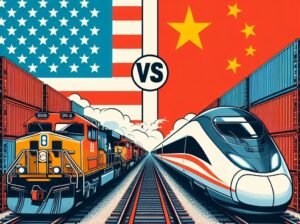by
Marcos Kleber R Felix
The railway authorizations, implemented in Brazil by Provisional Measure No. 1.065 of 2021, and ratified by Law No. 14.273, also of 2021, during the Bolsonaro administration, are the most successful railway policy that the country has implemented in the last 100 years.
This article seeks to explore and analyze the factors that contributed to this assessment. Through a comparative analysis, we will present the strategies adopted, the challenges overcome, and the lessons learned over the past few years to develop the Brazilian railway sector.
This text not only celebrates the success achieved but also aims to provide valuable insights that can guide future public policies in railway infrastructure.
The Recent Evolution of Railway Policy in Brazil
To demonstrate the success of the railway authorization legislation in Brazil, we will present some comparative facts regarding the Dilma Rousseff Government, which was the most prominent in the attempt to implement public railways in the country in recent years, through the Logistics Investment Plan (PIL), only surpassed in boldness by President Médici, who in the 1970s launched the National Plan of Transportation (PNV), which aimed to construct about 30,000 km of new railways.
Médici’s National Plan was not successful. Since its edition, the Brazilian railway network has been regressing instead of growing. The country went from 30.5 thousand km of installed tracks in 1973 to about 20 thousand km of active installed tracks in 2021. Dilma’s PIL was no different.
During the government of President Dilma, 10 new railway projects were proposed through public, common, or sponsored concessions, totaling 14,365 km of new railway lines.
PIL: A Plan with No Market Interest
None of Dilma’s PIL projects were carried forward in partnerships with the private sector for a variety of reasons, the main one being fiscal scarcity.
The total cost of the PIL, just for railways, would be R$ 164.68 billion at 2012 prices, which was approximately $ 84.23 billion USD, considering that the estimated cost per km of railway at that time was R$ 11.45 million per kilometer, or approximately $5.86 million USD per kilometer. Simply put, the bill did not fit into the public Brazilian budget.
If we consider it reasonable that it would take 20 years to complete the construction of the new 14 thousand km of new railways, it would be necessary to octuple the federal railway public budget.
It simply was not credible that the Brazilian State could invest eight times more than it had been investing that time for the next 20 years. The market did not believe this.
The Brazilian market vehemently rejected the PIL railways. In addition to the extremely high fiscal risk of default by the Brazilian Government, the model also brought implicit risks in the model of separating the management of the tracks from the operation of the trains.
The Plan for Early Renewal of Contracts
The so-called open access model of Dilma put in PIL was revoked by President Michel Temer as soon as he took office, proposing a new strategy: the early renewal of contracts for existing railway concessions.
This public policy provided that the railway concession contracts established in the mid-1990s would be renewed early in exchange for compulsory investments in networks of interest to the Union.
Through this public policy, it would be possible to: double the main railway for access of grains from the Brazilian Midwest to the port of Santos, build a new railway linking EF-151 in Mara Rosa in Goiás to Água Boa in Mato Grosso; revitalize the wide gauge lines that connect São Paulo, Minas Gerais, and Rio de Janeiro; and invest in tracks for the continuation of the West-East Integration Railway (FIOL), which intends to connect the south of Bahia to Tocantins.
In total, the early renewal policy provided for the possibility of injecting at least R$ 47 billion (approximately $13.47 billion USD at 2016 exchange rates) in railway investments over a 30-year period, by the concessionaire companies, without having to withdraw a single cent from the Treasury.
Although Temer’s Railway Policy had brought great advances, much more would still need to be done so that all the repressed Brazilian railway demand could be met.
PIL versus the New Model of Railway Authorizations
During the Bolsonaro administration, legislation was indeed introduced that opened the railway market. This allowed for railway authorizations as market economic activities, which was a significant change from the existing Brazilian model.
Previously, railways were interpreted as public service concessions owned by the Union. This new legislation allowed for a greater involvement of private entities in the railway sector. In other words, Brazil did not allow privately owned railways for almost a century, until the Provisional Measure No. 1.065 of 2021.
Unlike the PIL, the market enthusiastically welcomed the new authorization model for privately owned railways. The Ministry of Infrastructure received 78 requests for new projects, of which 21 were contracted in 2021. Another 25 were contracted between 2022 and 2023.
However, the vetoes that Bolsonaro raised to the more bureaucratic devices brought in Law No. 14,273, of 2021, were overturned by Congress last year, effectively stopping all processes of granting new authorizations for private entities to build new railways in Brazil.
The railway authorization regime is better for the market because it is simpler and less bureaucratic, allowing greater flexibility and agility in the implementation of new branches and railway sections. In addition, it guarantees better access to the financial market, both Brazilian and international, attracting new investments to the railway sector.
The projection of private resources to be allocated in the implementation of the already granted enterprises amounts to approximately R$ 225 billion (approximately $ 45 billion USD, by the 2024 exchange rate), and 12 thousand km of new railways are expected. However, all this can be wasted by Lula’s Government, which is not the biggest fan of business freedoms.
The railway authorizations law offered regulatory flexibility that allows quick adjustments to market changes and investor needs. This is crucial to keep the railway sector competitive and adaptable.
In addition, the authorization regime encourages innovation by allowing different private entities to explore new technologies and methods of railway construction and management. As if all this were not enough, the Authorization Law was the first to bring concrete incentive mechanisms to passenger rail transport, which has been long forgotten in Brazil.
International and Historical Evidence that Railway Authorizations are Viable.
Those who consider the numbers of Brazilian Railway Authorizations inflated forget that until 1900 there were about 82 different railways in Brazil, managed by about 45 independent companies, responsible for the construction of 15,316 km. Reviving this railway boom is not only possible but has already been done by Brazil in a timid way in the 19th century.
Timidly, because at the same time, the USA, having a more attractive regulatory regime than the Brazilian one, implemented an impressive 311,159 km of tracks by more than a thousand different private companies.
Skeptics may think that this was only possible in the 19th century and that railways are no longer so relevant today. However, they are forgetting the lessons from China, which in the mid-1960s had the same amount of 35,000 km of installed tracks as Brazil did, but what is worse, it was a poorer country than Brazil.
Largely due to investments in industrialization and transport infrastructure, today China has 159,000 km of active tracks installed and is the world’s 2nd largest economy, while Brazil has regressed to about 20,000 km of active tracks installed and is the 8th largest economy in the world.
The Future of Railways in Brazil
Although empirical evidence shows that Brazilian Railway Authorizations are the best alternative to get the country on track, without the support of the Federal Government, this public policy runs a serious risk of hibernating and only re-emerging when there is a change in governmental attitude.
Insisting on the fiscal budget as Médici and Dilma did will likely result in the same outcomes, the lessons of history are there to be learned, not forgotten. Without economic pragmatism, the result tends to be the same as before.
Brazil will only resume the path of rail development when it prioritizes and respects the following four fundamental pillars: market freedom, ensuring competitiveness and innovation; legal security for companies, providing a stable and predictable business environment; the recognition of railways as the ideal environmental solution for logistics, highlighting their role in sustainability; and the consideration of demand as the main factor in selecting priorities, ensuring that real needs are met.
The integration of these four pillars, today forgotten or underestimated, is essential to boost the economy and promote sustainable growth, as well as to strengthen the infrastructure and competitiveness of the country on the global stage. Without this, Brazil will continue with beautiful National Railway Plans that never leave the drawing board.
Notes:
Este artigo possui uma versão em português.
References:
Agência Nacional de Transportes Terrestres – ANTT. (2024). Autorizações Ferroviárias. ANTT
Brazil. (2016a). Decreto nº 8.875, de 11 de outubro de 2016. Presidency of the Republic of Brazil.
Brazil. (2016b). Provisional Measure nº 752, fo 2016. Presidency of the Republic of Brazil.
Brazil. (2021a). Provisional Measure No. 1.065 of 2021. Presidency of the Republic of Brazil.
Brazil. (2021b) Lei nº 14.273, de 24 de dezembro de 2021. Presidency of the Republic of Brazil.
Dalto, E. J., Castro, N. T. de S., & Passos, P. (2023). SHORTLINES: O desafio de implantá-las no Brasil. BNDES Set., Rio de Janeiro, v. 29, n. 57, p. 5-71.
Felix, M. K. R. (2018). Exploração de infraestrutura ferroviária: lições de extremos para o Brasil , Publicação T.DM – 001/2018, Departamento de Engenharia Civil e Ambiental, Universidade de Brasília, Brasília, DF.
Felix, M.K.R. (2024) China versus USA: a Railway Comparison. Ousebem.
Quintella, M. (2022). Autorizações ferroviárias: Um avanço para o desenvolvimento do país. Agência iNFRA.
Revista OE (2012). Orçamento em transportes foi R$ 15,9 bilhões, em 2012. Revista OE.



